Click image for BBB rating
See our Privacy Policy
cool="cool" width="784" height="9140" border="0" cellpadding="0" cellspacing="0" gridx="16" showgridx="showgridx" usegridx="usegridx" gridy="16" showgridy="showgridy" usegridy="usegridy" bgcolor="#99ccff">
|
|
|
 |
|
|
|
|
|
|
Welcome to Spaightwood Galleries, Inc.
120 Main Street, Upton MA 01568-6193
You can follow us on Facebook and Twitter!
We blog regularly on Facebook and announce special events and special sales on both sites.
Old Master Prints: Albrecht Durer (Nuremburg, 1471-1528): The Small Woodcut Passion I
|
|
|
|
|
According to Walter Strauss (Albrecht Durer Woodcuts and Wood Blocks [NY: Abaris Books, 1980], p. 342 and after), Durer may have begun the the Small Woodcut Passion as early as 1502 or 1503, though most of the woodcuts proabably date to 1508-1510. It was completed in 1510 and published it in 1511 with Latin verses by Benedictus Chelidonius facing each plate. Some trial proofs before the first edition exist and impressions were printed from Dürer's original woodblocks up until 1612, when an Italian edition was printed from Dürer's original woodblocks. There are thirty-seven woodcuts in the series, beginning The Fall of Man and concluding with The Last Judgment. While only a few of the plates are dated, those that are suggest that Durer originally began with Christ's Entry into Jerusalem on Palm Sunday and concluded with The Last Judgment. As he was completing the series c. 1510, however, he added The Fall of Man, The Expulsion from Eden (dated 1510), The Annunciation, The Nativity, and Saints Peter, Paul, and Veronica holding the Suderium (dated 1510). These additions change the focus from a history of The Passion to a history of mankind with Adam and Eve as the source of man's woes and Jesus as man's salvation. Of all of Durer's great works in series, the Small Woodcut Passion is by far the largest. It was also one of his most popular: it was reprinted several times up to an Italian edition of 1612. Although there exist later impressions printed from Durer's original blocks, they are gray and blotchy and do not print well. In addition to the prints made from Durer's woodblocks and the copies by Marantonio Raimondi (engravings published in Venice in the early 16th century), Virgil Solis (published in Nurenberg in the late 16th century with Solis' monogram VS, and a set of very deceptive copies by Mommard published a bit later, there exists as well a set made in the 19th century from metal plates made from plaster casts of thirty-five of Durer's original woodblocks after they were given to the British Museum in 1839. In 1844 Henry Cole of the South Kensington Museum (now the Victoria and Albert Museum) published his edition of the the Durer Small Passion woodcuts and described the process by which they were made:
"The present work, with the exception of two subjects, is taken from the original engravings drawn by Albrecht Durer himself on the wood, and engraved under his own superintendence. [The consensus is that Durer cut the blocks himself for his early works including The Ship of Fools until he could train professional woodcutters to reach the level he had achieved, worlds beyond anything anyone had done up to that time in terms of subtlety, fineness of line, density, etc.] . . . [T]he present, it is believed makes the fourth edition of the genuine blocks. I say genuine blocks, for so great was the popularity and estimation of the work, that there has been more than one obvious imitation of them, besides several avowed copies constantly circulating throughout Europe. The Small Passion is stated by all writers on the subject . . . to have originally consisted of thirty-seven subjects. . . . [He then distinguishes two lifetime editions of the complete work, as opposed to individual printings of individual works that Durer sold or gave away when he traveled]. The third edition of the genuine woodcuts was published at Venice, in 1612, by a Librarian who, according to Heinecke, purchased them in the Netherlands. . . . The engravings republished in the present volumes are from the same blocks. Thirty-five of the thirty-seven of them have found a secure resting place in the British Museum. They were purchased in 1839 by Mr. Josi, the present keeper of the prints, from the Rev. P. E. Boissier, whose father bought them many years ago in Italy. . . . The four impressions of these blocks which were printed by Mr. Otley in his History of Engraving, (p. 730) show the extent of the damage which the blocks have suffered. But in the present edition of them, the defects have been remedied by using stereotype casts of the blocks, which have been taken by a special permission of the trustees of the British Museum [that would never have happened in this century!]. New border lines have been added, the worm-holes stopped, and those parts skillfully recut by Mr. Thurston Thompson, who has also re-engraved with full feeling, the subjects of the Sitting Christ and of Jesus Parting from his Mother. The process of stereotyping has had the good effect of restoring almost the original sharpness and crispness of the lines, and of rendering the present impressions nearer the state of the earliest impressions than they would have been had they been taken from the blocks themselves. This statement may seem paradoxical, but it will be seen that it has a reasonable explanation. In order to take a metal cast of a woodcut, a cast is first taken in moist plaster of Paris. This is thoroughly dried by baking, which causes it to shrink throughout, sometimes as much as the eighth of an inch in a cast of six inches in length. The result of this slight shrinkage has been to reduce these thickened lines nearly to their original fineness, and several of the present impressions are so crisp and clear that they will not suffer by comparison with choice early impressions."
We offer a selection if impressions ranging from Durer's first edition lifetime proofs to later editions and include some of the 1844 impressions as well.
Select bibliography: Walter L. Strauss in his catalogue raisonne, Albrecht Durer Woodcuts and Woodblocks (Abaris Books, 1980), provides a summary of comments upon each individaul work. Strauss' Commentary volume in the Illustrated Bartsch series updates his earlier commentary and gives details on copies of Dürer's prints. As always, Panofsky's Life and Art of Albrecht Durer (Princeton University Press, 1943, revised editions all preserving the original pagination) is crucial for an understanding of the work of this great artist and printmaker. The "Handlist" in volume 2 of the 1943, 1945, and 1948 editions of Panofsky's magnum opus contains entries on many of the works in the series; unfortunately, editions of the one-volume edition from 1955 onward do not include the Handlist.
|
|
|
|
|
|
|
|
|
|
|
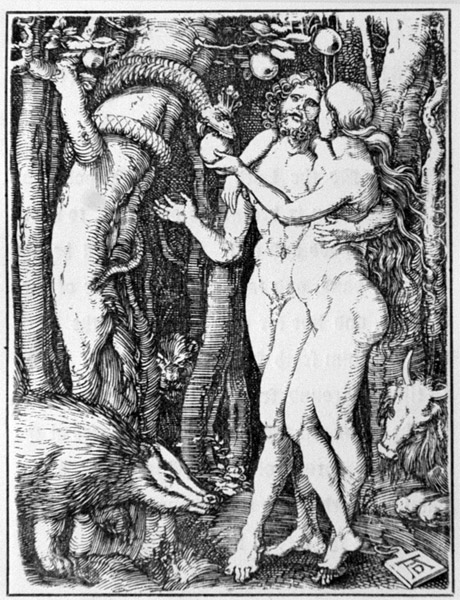 |
|
The Fall of Man. (Bartsch 17, Strauss 137) Original woodcut, c. 1510 for the Small Passion. In 1844 plaster casts were made from Dürer's original woodblocks for the Small Woodcut Passion, which had just been acquired by the British Museum. From these casts, metal plates were made and a small edition produced. Our impression is from this edition. Image size: 125x96mm. Price: Please call or email for current pricing information.
|
|
|
|
|
|
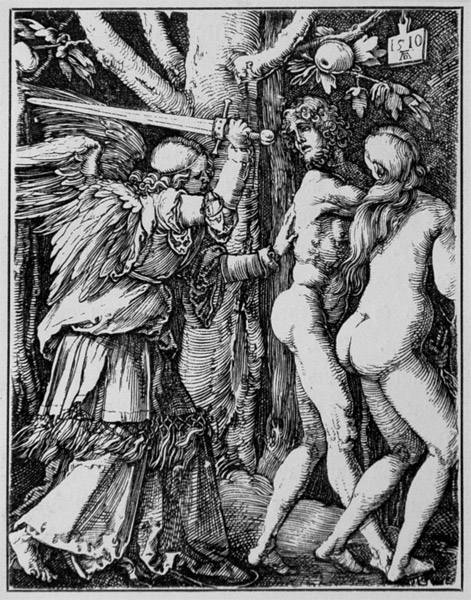 |
|
The Expulsion from Eden (B. 18, S. 138). Original woodcut, c. 1510 for the Small Passion. In 1844 plaster casts were made from Dürer's original woodblocks for the Small Woodcut Passion, which had just been acquired by the British Museum. From these casts, metal plates were made and a small edition produced. Our impression is from this edition. Image size: 125x96mm. Price: Please call or email for current pricing information.
|
|
|
|
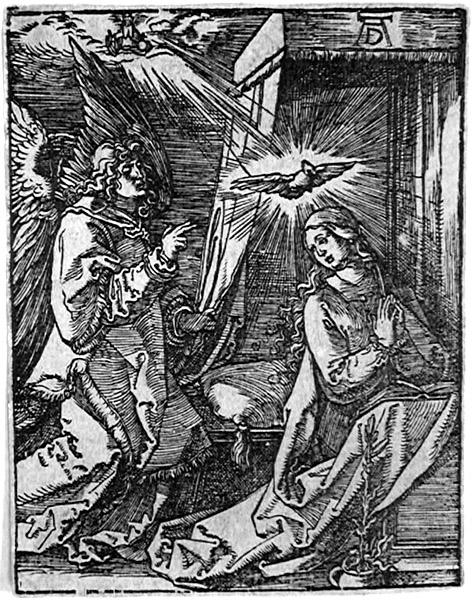 |
|
The Annunciation to the Virgin (B. 19, Meder 128b, Strauss 139). Original woodcut, c. 1508. A good 16th century impression with thread margins outside the border. Altough the border is beginning to chip, the block is still printing well. 126x97mm. Price: Please call or email for current pricing information.
|
|
|
|
|
|
|
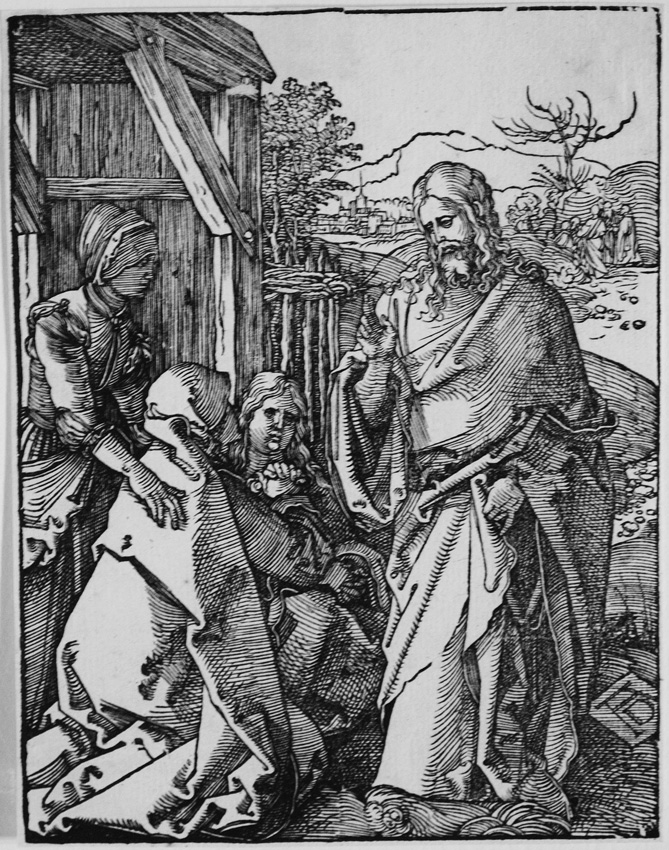 |
|
Christ Taking Leave of HIs Mother (B. 21, S. 108), Meder 132. Original woodcut, c. 1508-1509. A very strong impression from just after the 1511 Latin text edition with strong contrasts. According to Meder, very early impressions have a single gap in the margin top right; impressions from the first edition in 1511 with Latin text verso have four small gaps top right; impressions without the Latin text after the first edition have seven small gaps top right (as ours). Strauss points out this this scene does not occur in the gospels or in the Golden Legend and instead derives from St. Bonaventura's Vita Christi. Image size: 125x96mm. Price: Please call or email for current pricing information.
|
|
|
|
 |
|
Christ's Entry into Jerusalem (B. 22, Strauss 106, Meder 130). Original woodcut, c. 1508-1509. Meder describes the impressions of this print as falling into three categories: before the text, the Latin bok edition of 1511, and without text. Ours belongs to the without text (a) state: "six gaps on top, one on bottom, and another on the right border just above the gate" (Strauss, Woodcuts, 342-43). Our impression almost exactly matches this description (the only difference is that ours has no gap at the bottom and a gap at the bottom of the left border, as in the photo at left). Meder also describes the 1511 Latin text edition as "overly inked," a description that might well be applied to ours as well, perhaps because the printer of our print was using an impression from the 1511 Latin text edition as a model, perhaps because ours was an unused sheet printed for the 1511 edition but lacking the printed text on the verso because it was not needed for the Latin book edition and not bound into the set. Strauss notes that Christ's Entry into Jerusalem "is not included in any of Dürer's other Passion series" and suggests that "Its composition is strikingly reminiscent to that of Master LCz's engraving of c. 1500, including the man spreading his garment before him on the right" and that "it also bears a close resemblance to Hans Schaufelein's illustration in Ulrich Pindar's Speculum Passionis, Nuremberg 1507" (p. 342). Image size: 127x97mm. Price: Please call or email for current pricing information.
|
|
|
|
|
|
 |
|
Christ Drivinig the Moneychangers from the Temple (B. 23, S. 107). Original woodcut, c. 1508-1509. In 1844 plaster casts were made from Dürer's original woodblocks for the Small Woodcut Passion, which had just been acquired by the British Museum. From these casts, metal plates were made and a small edition produced. Our impression is from this edition. Image size: 125x96mm. Price: Please call or email for current pricing information.
|
|
|
|
|
 |
|
The Last Supper (B. 24, S. 109, Meder 133). Original woodcut, c. 1508-1509. In a room appparently lit by Jesus' glory, our attention is drawn primarily to Jesus, St. John leaning on Jesus, and Judas in the foreground holding the purse by his left knee with his left hand. The apostles are clustered around a round table as opposed to the rectangular table in the Large Woodcut Passion and in The Last Supper of 1523. In 1844 plaster casts were made from Dürer's original woodblocks for the Small Woodcut Passion, which had just been acquired by the British Museum. From these casts, metal plates were made and a small edition produced. Our impression is from this edition. Image size: 127x98mm. Price: Please call or email for current pricing information.
|
|
|
|
 |
|
Jesus washing St. Peter's Feet (B. 25, S. 110, Meder 134). Original woodcut, c. 1509-1510 (per Panofsky). The room is now lit only by 2 candles, Judas has already left to betray Jesus (Strauss suggests that the man immediately behind St. John is "not one of the diciples but the innkeeper, St. Peter in the foreground is exceedingly confused, St. John, standing immediately behind Jesus is watching attentively, and the other disciples seem to be talking with each other about what is happening. In 1844 plaster casts were made from Dürer's original woodblocks for the Small Woodcut Passion, which had just been acquired by the British Museum. From these casts, metal plates were made and a small edition produced. Our impression is from this edition. Image size: 127x97mm. Price: Please call or email for current pricing information.
|
|
|
|
|
|
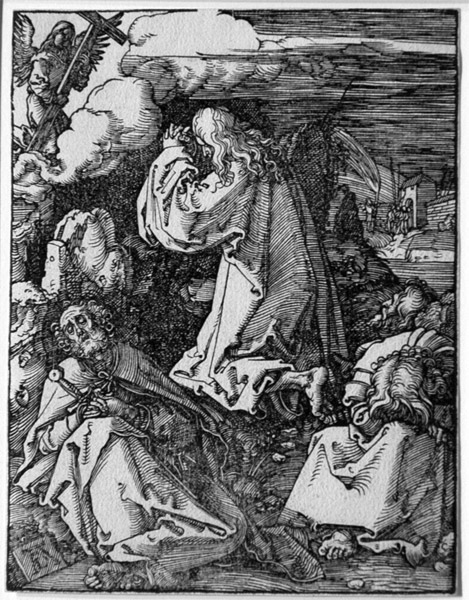 |
|
The Agony in the Garden (B. 26, S. 142). Original woodcut, c. 1510. A very good early 16th-century impression on laid paper after the first published edition (no text on verso). The block prints darkly and there is only one small break in the border, top center. Wolfflin calls this the most perfect of the series (see Strauss, p. 414). Strauss notes that "this woodcut has been praised for the realistic rendition of the prayerful attitude of Christ and the sleeping disciples–they actually appear to be asleep, not merely with their eyes closed." Image size: 124x95mm. Price: Please call or email for current pricing information.
|
|
|
|
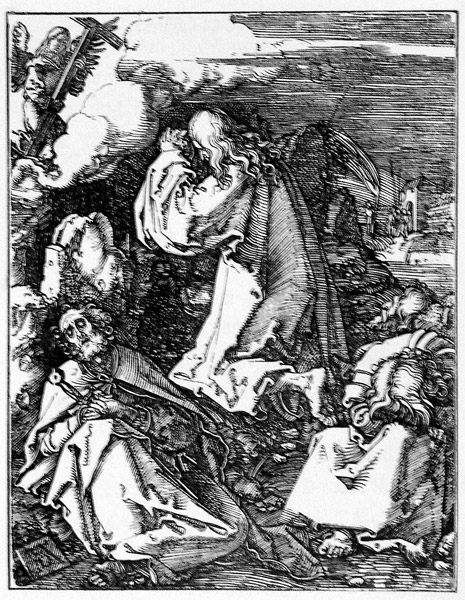 |
|
The Agony in the Garden (B. 26, S. 142). Original woodcut, c. 1510. In 1844 plaster casts were made from Dürer's original woodblocks for the Small Woodcut Passion, which had just been acquired by the British Museum. From these casts, metal plates were made and a small edition produced. Our impression is from this edition. Wolfflin calls this the most perfect of the series (see Strauss, p. 414). Strauss notes that "this woodcut hasa been praised for the realistic rendition of the prayerful attitude of Christ and the sleeping disciples–they actually appear to be asleep, not merely with their eyes closed." Image size: 125x96mm. Price: Please call or email for current pricing information.
|
|
|
|
|
|
|
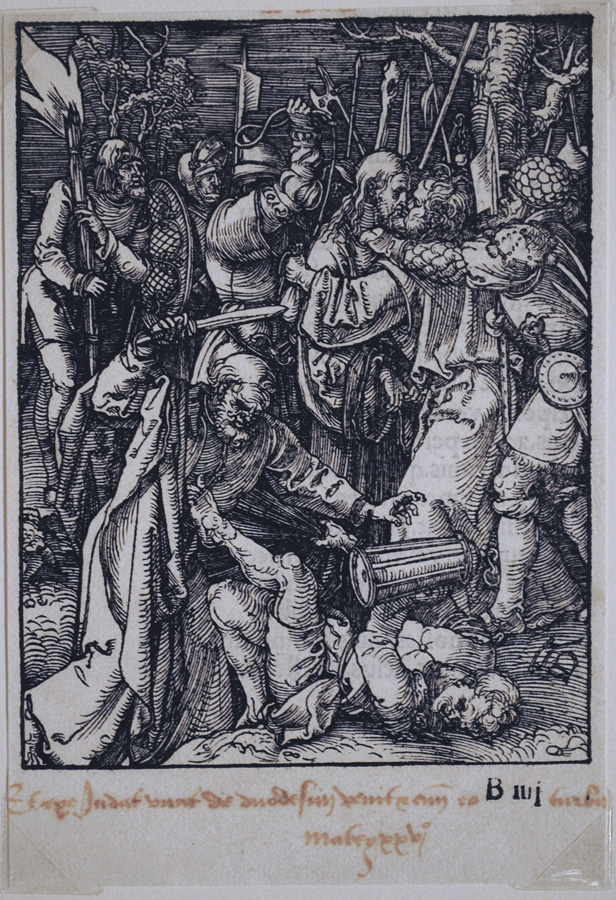 |
|
The Betrayal of Christ (B. 27, S. 112, M. 136). Original woodcut, 1509-11. A superb, dark, and well-inked impression from the 1511 book edition with the Latin text on the verso, the first complete publication of the series and the only one with this Latin text on the verso. This rich impression boasts strong contrasts and no sign of wear. Full borders on all sides; annotations in orange ink at bottom; signature Biij as called for in the 1511 book edition. Signed with the monogram lower right. Dürer treated the same subject in his Engraved Passion in 1508 and in the Large Passion in 1510. Image size: 127x95mm. Price: Please call or email for current pricing information.
|
|
|
|
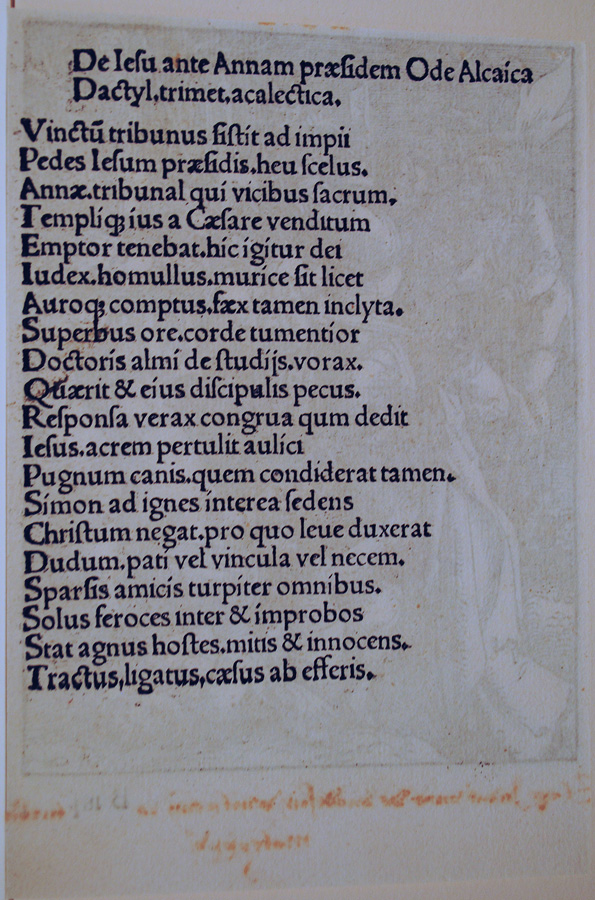 |
|
The Betrayal of Christ (B. 27, S. 112, M. 136). Original woodcut, 1509-11. A superb, dark, and well-inked impression from the 1511 book edition with the Latin text on the verso. From the 1511 first edition of the Small Woodcut Passion with verses on the verso by Benedictus Chelidonius. The text relates to the woodcut that follows the Betrayal, Christ before Annas. The text is only to be found in the 1511 edition of the Small Woodcut Passion.
Sorry that the verso was photographed at an angle.
|
|
|
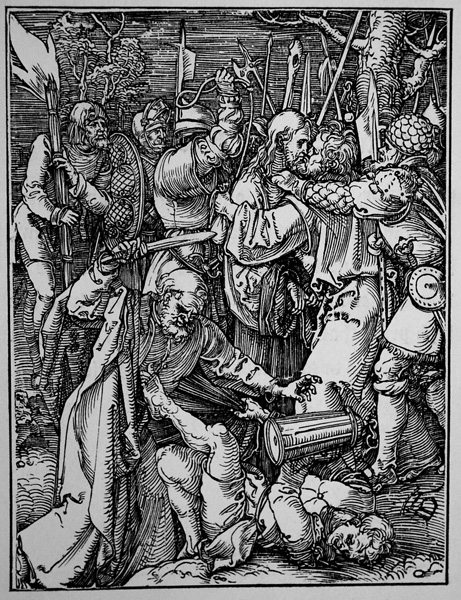 |
|
|
|
|
The Betrayal of Christ (B. 27, S. 112). Original woodcut, c. 1509. In 1844 plaster casts were made from Dürer's original woodblocks for the Small Woodcut Passion, which had just been acquired by the British Museum. From these casts, metal plates were made and a small edition produced. Our impression is from this edition. Dürer treated the same subject in his Engraved Passion in 1508 and in the Large Passion in 1510. Image size: 127x95mm. Price: Please call or email for current pricing information.
|
|
|
|
Spaightwood Galleries, Inc.
To purchase, call us at 1-800-809-3343 (1-508-529-2511 in Upton MA & vicinity) or send an email to spaightwood@gmail.com
We accept AmericanExpress, DiscoverCard, MasterCard, and Visa.
We also accept wire transfers and paypal.
For directions and visiting information, please call. We are, of course, always available over the web and by telephone (see above for contact information). Click the following for links to past shows and artists. For a visual tour of the gallery, please click here. For information about Andy Weiner and Sonja Hansard-Weiner, please click here. For a list of special offers currently available, see Specials.
All works are sold with an unconditional guarantee of authenticity (as described in our website listing).
Copyright 2004-2017, Spaightwood Galleries, Inc.
Go back to the top of this page.
Visiting hours: Saturday 10:00 am to 5:00 pm and Sunday noon to 6:00 pm and other times by arrangement.
Please call to confirm your visit. Browsers and guests are welcome.
|
|
|
|
|
|
|
|
|
|
|
|
|
|
|
|
|
|
|
|
|
|
|
|
|
|
|
|
|
|
|
|
|
|
|
|












